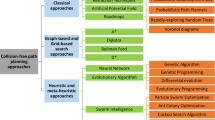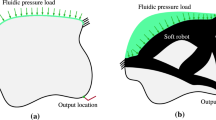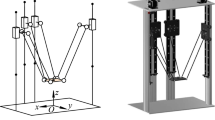Abstract
Kinematic redundancy is a way to enlarge the workspace and to eliminate the singularities of parallel mechanisms. The objective of the present research is to introduce a new motion planning strategy for singularity avoidance and reducing the actuator forces, especially in the vicinity of singular configurations. The method is implemented to a planar kinematically redundant mechanism categorized as 3-RPRR type. Dynamic equations of motion are derived using the principle of virtual work, and the optimum inverse dynamics is obtained. Some numerical examples are solved, and the results are compared with those obtained in the counterpart non-redundant mechanisms. It is illustrated that the redundant mechanism can avoid singular configurations and track the given trajectory with feasible generalized forces.














Similar content being viewed by others
Abbreviations
- a :
-
Dimension of the moving plate, Length of node pairs ppi (m)
- b :
-
Length of node pairs OOi (m)
- ℓ :
-
Length of the intermediate links (m)
- \( {\mathbf{p}} \) :
-
Position vector of the center of the moving plate (m)
- θ :
-
Orientation of the moving plate (rad)
- θ i :
-
Angular position of the revolute actuators (rad)
- d i :
-
Length of the prismatic actuators (m)
- \( {\mathbf{A}}_{\theta } \) :
-
The rotation matrix from the moving plate to the reference frame
- \( {\bar{\mathbf{u}}}_{p} \) :
-
Position vector of point, pi with respect to point p
- \( {\mathbf{r}}_{pi} \) :
-
Position vector of point, pi
- \( {\mathbf{r}}_{oi} \) :
-
Position vector of point, oi
- \( {\mathbf{r}}_{bi} \) :
-
Position vector of point, bi
- β i :
-
Orientation of the intermediate link (rad)
- ω i :
-
Angular velocity of the intermediate links (rad/s)
- α i :
-
Angular acceleration of the intermediate links (rad/s2)
- \( {\mathbf{s}}_{i} \) :
-
Unit vector from point bi to pi
- m p :
-
Mass of the moving plate (kg)
- J p :
-
Inertia of the moving plate (kg m2)
- J b :
-
Inertia of the prismatic actuators (kg m2)
- F i :
-
Force of the ith prismatic actuator (N)
- M i :
-
Moment of the ith revolute actuator (N m)
References
Abadi BN, Taghvaei S, Vatankhah R (2016) Optimal motion planning of a planar parallel manipulator with kinematically redundant degrees of freedom. Trans Can Soc Mech Eng 40(3):383
Assal SF (2015) A novel planar parallel manipulator with high orientation capability for a hybrid machine tool: kinematics, dimensional synthesis and performance evaluation. Robotica 1:1–23
Bonev IA, Zlatanov D, Gosselin CM (2003) Singularity analysis of 3-DOF planar parallel mechanisms via screw theory. J Mech Des 125(3):573–581
Boudreau R, Nokleby S (2012) Force optimization of kinematically-redundant planar parallel manipulators following a desired trajectory. Mech Mach Theory 31(56):138–155
Carretero JA, Ebrahimi I, Boudreau R (2012) Overall motion planning for kinematically redundant parallel manipulators. J Mech Robot 4(2):024502
Cha SH, Lasky TA, Velinsky SA (2007) Singularity avoidance for the 3-RRR mechanism using kinematic redundancy. In: 2007 IEEE international conference on robotics and automation, IEEE, pp 1195–1200
Do Thanh T, Kotlarski J, Heimann B, Ortmaier T (2012) Dynamics identification of kinematically redundant parallel robots using the direct search method. Mech Mach Theory 30(52):277–295
Ebrahimi I, Carretero JA, Boudreau R (2007) Path planning for the 3-PRRR redundant planar parallel manipulator. In: Proceedings of the 2007 IFToMM world congress
Ebrahimi I, Carretero JA, Boudreau R (2007b) 3-PRRR redundant planar parallel manipulator: inverse displacement, workspace and singularity analyses. Mech Mach Theory 42(8):1007–1016
Ebrahimi I, Carretero JA, Boudreau R (2008a) A family of kinematically redundant planar parallel manipulators. J Mech Des 130(6):062306
Ebrahimi I, Carretero JA, Boudreau R (2008b) Kinematic analysis and path planning of a new kinematically redundant planar parallel manipulator. Robotica 26(3):405–413
Fontes JV, da Silva MM (2016) On the dynamic performance of parallel kinematic manipulators with actuation and kinematic redundancies. Mech Mach Theory 30(103):148–166
Fontes J, Santos JC, da Silva MM (2014) Torque optimization of parallel manipulators by the application of kinematic redundancy. In: Conferência Nacional de Engenharia Mecânica-CONEM
Fontes JV, Santos JC, da Silva MM (2014) Optimization strategies for actuators of kinematically redundant manipulators to achieve high dynamic performance. In: 2014 joint conference on robotics: SBR-LARS robotics symposium and robocontrol (SBR LARS Robocontrol), IEEE, pp 31–36
Gosselin C, Angeles J (1990) Singularity analysis of closed-loop kinematic chains. IEEE Trans Robot Autom 6(3):281–290
Gosselin C, Schreiber LT (2016) Kinematically redundant spatial parallel mechanisms for singularity avoidance and large orientational workspace. IEEE Trans Robot 32(2):286–300
Isaksson M (2017) Kinematically redundant planar parallel mechanisms for optimal singularity avoidance. J Mech Des 139(4):042302
Isaksson M, Gosselin C, Marlow K (2016) An introduction to utilising the redundancy of a kinematically redundant parallel manipulator to operate a gripper. Mech Mach Theory 31(101):50–59
Jiang Y, Li TM, Wang LP (2015) Dynamic modeling and redundant force optimization of a 2-DOF parallel kinematic machine with kinematic redundancy. Robot Comput Integr Manuf 30(32):1
Kim J, Park C, Kim J, Park FC (2000) Performance analysis of parallel mechanism architectures for CNC machining applications. J Manuf Sci Eng 122(4):753–759
Kotlarski J, Abdellatif H, Heimann B (2008) Improving the pose accuracy of a planar 3RRR parallel manipulator using kinematic redundancy and optimized switching patterns. In: IEEE international conference on robotics and automation. ICRA 2008, IEEE, pp 3863–3868
Liu H, Huang T, Kecskeméthy A, Chetwynd DG, Li Q (2017) Force/motion transmissibility analyses of redundantly actuated and overconstrained parallel manipulators. Mech Mach Theory 31(109):126–138
Luces M, Mills JK, Benhabib B (2017) A review of redundant parallel kinematic mechanisms. J Intell Robot Syst 86(2):175–198
Mejia L, Simas H, Martins D (2016) Wrench capability in redundant planar parallel manipulators with net degree of constraint equal to four, five or six. Mech Mach Theory 105:58–79
Merlet JP (2006) Parallel robots. Springer, Berlin
Mohamed MG, Gosselin CM (2005) Design and analysis of kinematically redundant parallel manipulators with configurable platforms. IEEE Trans Robot 21(3):277–287
Müller A (2013) On the terminology and geometric aspects of redundant parallel manipulators. Robotica 31(1):137–147
Ruggiu M, Carretero JA (2010) Actuation strategy based on the acceleration model for the 3-PRPR redundant planar parallel manipulator. Adv Robot Kinemat Motion Man Mach 1:91–98
Ruiz AG, Fontes J, da Silva MM (2015) The impact of kinematic and actuation redundancy on the energy efficiency of planar parallel kinematic machines. In: 17th international symposium on dynamic problems of mechanics, Natal, Brazil, pp 22–27
Wang J, Gosselin CM (2004) Kinematic analysis and design of kinematically redundant parallel mechanisms. Trans Am Soc Mech Eng J Mech Des 126(1):109–118
Weihmann L, Martins D, Coelho LS, Bernert D (2011) Force capabilities of kinematically redundant planar parallel manipulators. In: 13th world congress in mechanism and machine science, p 483
Xie F, Liu XJ, Wang J (2011) Performance evaluation of redundant parallel manipulators assimilating motion/force transmissibility. Int J Adv Robot Syst 8(5):66
Author information
Authors and Affiliations
Corresponding author
Rights and permissions
About this article
Cite this article
Nouri Rahmat Abadi, B., Mahzoon, M. & Farid, M. Singularity-Free Trajectory Planning of a 3-RPRR Planar Kinematically Redundant Parallel Mechanism for Minimum Actuating Effort. Iran J Sci Technol Trans Mech Eng 43, 739–751 (2019). https://doi.org/10.1007/s40997-018-0234-1
Received:
Accepted:
Published:
Issue Date:
DOI: https://doi.org/10.1007/s40997-018-0234-1




